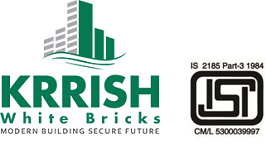History About ACC Blocks
Autoclaved Aerated Concrete (AAC), also known as Autoclaved Cellular Concrete (ACC),Autoclaved Lightweight Concrete (ALC) is a lightweight, precast, foam concrete building material invented in the mid-1920s that simultaneously provides structure, insulation, and fire – and mold- resistance and various other advantages. It is also an environment friendly product, as it is manufactured using 65-70% of sand/ fly ash (by weight). Due to its many desirable attributes, AAC Blocks has gained massive popularity in Northern, Western and Southern India with almost 80 percent of the constructions using AAC Blocks as a replacement of the traditional fried clay bricks. In the North Eastern region, it is gaining popularity since 2012 and is looking to completely replace the use of traditional fried clay bricks.
AAC was perfected in the mid-1920s by the Swedish architect and inventor Dr.Johan Axel Eriksson, working with Professor HenrikKreuger at the Royal Institute of Technology. The process was patented in 1924. In 1929, production started in Sweden at the city of Yxhult. From “YxhultAnghardadeGasbetong” later became the first registered building materials brand in the world: Ytong. The second major international cellular concrete Hebel brand goes back to company founder and technicians Josef Hebel from Memmingen. In 1943, the first Hebel-plant was opened in Germany.
Originally Ytong autoclaved aerated concrete in Sweden was produced with alum shale, whose combustible carbon content made it beneficial to use in the production process. Unfortunately, the slate deposits used for Ytong in Sweden also contains a very low level of natural content uranium, which makes the material give off radioactive radon gas to the building. By using new recipes, containing only Quartz sand/ Fly ash ,Calcined gypsum, Lime(mineral),Cement, Water and Aluminum powder, after 1975, Ytong produced a new type of aerated concrete blocks which doesn’t contain alum slate anymore and thus the problem of radon exposure from this raw material eliminated since this time. The production of this white autoclaved aerated concrete is state of the art since those days and similar recipes are used by all producers all over the world.



